( this was presented in Open Show Bangalore #8. For more info please visit http://openshow.org/)
The tribe
Halakki tribe is pure agriculturist tribes inhabitants of coastal areas of Uttarakannada district of Karnataka ( India) with a very rich folklore history. They call themselves as descendants of Lord Shiva. One of their most celebrated event is called Suggi dance performed during the Holi festival .

How it started
Suggi dance is performed by men. Researchers have proved that agriculture is started by women while men used to be hunting for the food. Once agriculture became more promising then agriculture is slowly transferred to men . As the harvesting season is over then men needed rest more than that a sort of entertainment such as music and dance .This is how suggi started as the mark of celebrations after the harvesting is over.
How do they do it
Halakki live in group of houses called Koppas and there will be one team of suggi from each Koppa. This is not a rule so the village heads will decide whether they perform Suggi that year or not. Suggi dance with full costume called “Hire Suggi” , with no costumes called ” Kire suggi” or “Bolu suggi”.
It starts on Dashami that is five days before Holi full moon day by a selected group of men do a pooja ( worship) in their tribe heads house and wear their suggi costumes , get a heavy makeup. Suggi costumes are very colorful highly decorated ,decorated turbans , peacock feathers and they dance to the tunes of their own music team. The music team among them uses Tala ( cymbals ) and Jaagate ( percussion) and sing their own songs in unique style. They move from Koppa to Koppa that is villages to village by walk and dance in almost ever temple nearby, village heads and most of the houses in the locality. ( There many rules and practices of the dance which I yet to document ) This dance is enjoyed from a small kid to the old people . The team gets ” Kanike” gift in terms of money , food, coconuts etc after the dance. So they move one to next house and so villages. They decide where to stay during the end of the day where they are given a heavy lunch and a good rest for the day. They are not allowed inside the houses . The next day again they get a heavy makeup , wear costumes , do a pooja and dance in that village head’s house and move forward. On an average they travel 40-50 kms by walk and dance in more than 100 houses! The energy and dedication behind this is truly amazing ! Last day that is full moon day they return back to their Koppa ( village) and there is a detailed ritual to be done the whole day. They don’t sleep that day , dance whole night and in the morning they remove their costumes and bath called “Kari snana” ( balck bath) to return back to their home.
Symbolism of the Suggi dance
Just like every traditional dance in India Suggi dance also carries a rich symbolism which is largely associated with nature. The y use a unique turban which is decorated with colorful ornaments, small wooden birds( now they use thermocol) , peacock feathers which resembles a tree. And the colors used are red , green yellow and white which symbolizes nature’s colors.
A good observation can show that the steps or moves other dancing style shows elements of nature such as waves of sea , curves of growing vines, flowing rivers to name few . The dance starts with slow movements of the step and then it accelerates and ends with high speed dance movements and steps which shows the different faces of nature. The style of woman is also simulated through the dance steps but interestingly there is no place for woman in the team. The accompanying music or songs are more like devotional songs which directly relate to Hindu Mythology.
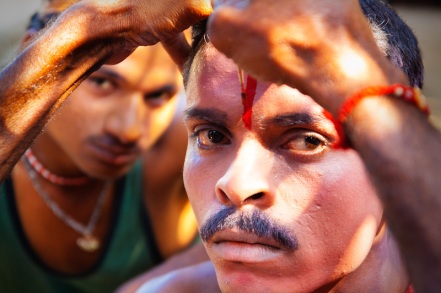


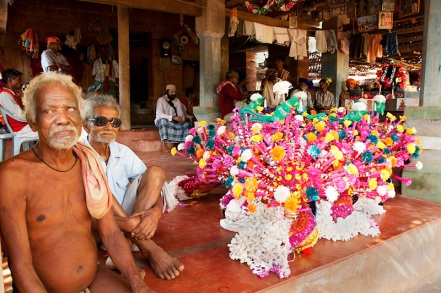





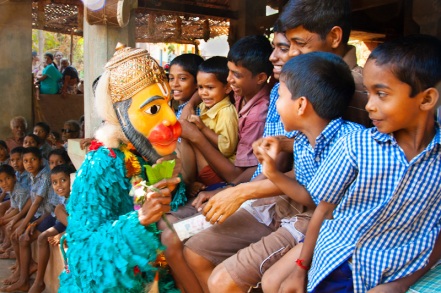
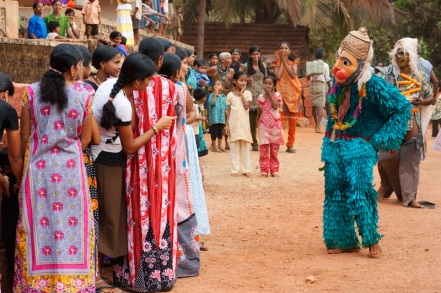

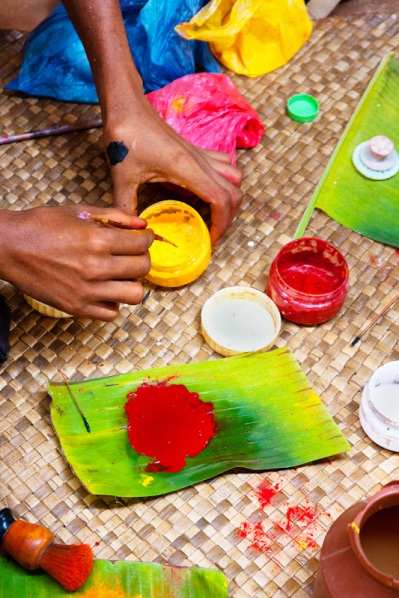

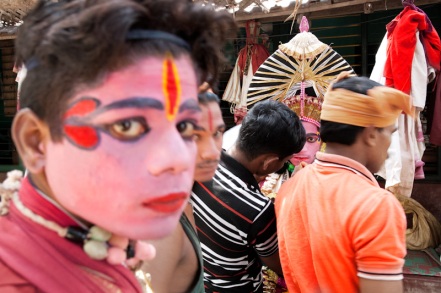

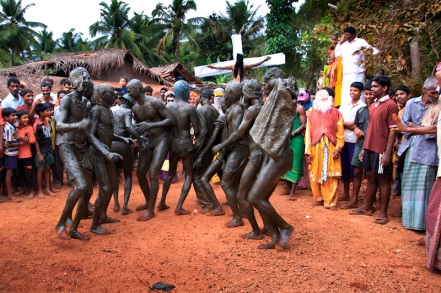

A full slide show of some portraits of incredible people.
[slideshow]The truth
Slowly this dance is dying due the effect of modernism just like every rich culture in India. The younger generation in the tribe are attracted towards city lifestyle and forgetting their ancestor’s practices and culture. Though lot of research has been done by university people Suggi dance but remains lesser known and those works are sitting in University libraries . This is an ongoing project of mine aims recording this in visual media and collect more and more information and document it and create a awareness to continue this culture.
There are lot of cultural group who invite these guys for the show but I do not encourage such events. There is a big difference in watching 5 minutes of dance on stage and enjoying 5 days of dance in the village. So please do visit this event and sponsor so that they can continue this wonderful culture.
Author’s note :
This is an ongoing project and might take several years to study and record the ins and outs of suggi dance and its observance in terms of visuals and words. It requires lot of effort, money and time . If anybody is interested in funding and using for editorial purposes please contact me at dmhmaneer@gmail.com

A word of thanks
There are so many to name but I would like to mention the important ones for whom I am so thankful.
The whole tribe people who allowed me to get closer to them and given permission to make photos
Dr G L Hegde who has given me so much information about this dance.
My good friend Sudheer Hegde who helped with traveling, lighting etc.
My good friend Gopi who helped me to get the info in a right time.
Equipments used
Canon EOS 1000d, Sigma 17-70mm lens,EF 50mm lens ( for the portraits) , tripod,flash, CPL filter
Location :Kumta, Honnavara, Sirsi, Karwar taluqs of Uttara Kannada district
Type: Agriculture
Occurrence: Annual
Time : March
Hindu Calendar time: starts one week before Holi festival and ends on Holi day
This story is part of my ongoing project ” Folk practices of Karnataka” from years. There is a need of visual documentation of these practices as most of the practices are either dying or changing due to modern metamorphosis . I am not in the favor of starting a debate whether these practices are good or bad and it is not up to my current knowledge . So please consider this body of work as photo-documentation of the practices.
How you can help me ?
- By reading these articles, looking at photos and sending me feedback, suggestions .
- By spreading these articles to the world by sharing on social networks , emails etc so that an awareness is created
- By Letting me know such practices in your region, reach if you think it deserves a visual record provided the region is Karnataka. You can send email to folkpractices@dineshmaneer.com and I will take necessary steps.
- By publishing the articles in your dailies , magazines, books etc which will benefit both financially as well as reaching people
- By buying photos, prints, offering me shelter 😉 when I am at your place for photographing .
ಇಲ್ಲಿ ಬರುವ ಲೇಖನಗಳು ಮತ್ತು ಛಾಯಾಚಿತ್ರಗಳು ನನ್ನ ” ಕರ್ನಾಟಕದ ಜನಪದ ಆಚರಣೆಗಳು” ಎಂಬ ಪ್ರಾಜೆಕ್ಟ್ ನ ಭಾಗಗಳಾಗಿವೆ. ಶತಮಾನಗಳಿಂದ ಆಚರಣೆಯಲ್ಲಿರುವ ಈ ನಶಿಸುತ್ತಿರುವ ಸಂಸ್ಕೃತಿಗಳನ್ನು ಚಿತ್ರಗಳಲ್ಲಿ ಹಿಡಿದಿಡುವ ಪ್ರಯತ್ನವನ್ನು ಕಳೆದ ಎರಡು ವರುಶಗಳಿಂದ ಮಾಡುತ್ತಿದ್ದೇನೆ . ಈ ಆಚರಣೆಗಳು ಸರಿಯೋ ತಪ್ಪೋ ಎನ್ನುವುದನ್ನು ಸಾರುವ ಉದ್ದೇಶ ನನ್ನದಲ್ಲ. ಅಲ್ಲದೇ ಅದು ನನ್ನ ಸದ್ಯದ ತಿಳುವಳಿಕೆಗೆ ಎಟುಕದ ವಿಷಯ. ಓದುಗರು ದಯವಿಟ್ಟು ಈ ಪ್ರಯತ್ನವನ್ನು ಆಚರಣೆಗಳ ಪರ ಹಾಗು ವಿರೋಧದ ಚರ್ಚೆಯಾಗಿ ತೆಗೆದುಕೊಳ್ಳದೆ ಇವುಗಳ ದೃಶ್ಯದಾಖಲೆಯಾಗಿ ಪರಿಗಣಿಸಬೇಕು ಎಂಬುದು ನನ್ನ ವಿನಂತಿ.
ನೀವು ಹೇಗೆ ನನಗೆ ಸಹಾಯ ಮಾಡಬಹುದು?
1) ಈ ದೃಶ್ಯಲೇಖನವನ್ನು ಓದುವುದರ ಮೂಲಕ , ಸಲಹೆಗಳನ್ನು ಕೊಡುವುದರ ಮೂಲಕ, ಪ್ರತಿಕ್ರಿಯೆಗಳನ್ನು ಕೊಡುವುದರ ಮೂಲಕ
2) ನಿಮ್ಮ ಗೆಳೆಯ ಬಂಧುಗಳಲ್ಲಿ ಈ ಕೊಂಡಿಯನ್ನು (link) ಹಂಚಿಕೊಳ್ಳುವುದರ ಮೂಲಕ
3) ನಿಮ್ಮ ಸನಿಹದಲ್ಲಿ ಈ ತರಹದ ಯಾವುದಾದರು ಅಚರಣೆಗಳಿದ್ದಲ್ಲಿ ಅವುಗಳನ್ನು ತಿಳಿಸುವುದರ ಮೂಲಕ
4) ಪತ್ರಿಕೆಗಳಲ್ಲಿ , ಸಾಪ್ತಾಹಿಕಗಳಲ್ಲಿ , ಮಾಸಿಕಗಳಲ್ಲಿ ಪ್ರಕಟಿಸುವುದರ ಮೂಲಕ, ಪುಸ್ತಕಗಳಲ್ಲಿ ಪ್ರಕಟಿಸುವುದರ ಮೂಲಕ
5) ಛಾಯಾಚಿತ್ರಗಳನ್ನು , ಚಿತ್ರಮುದ್ರಣಗಳನ್ನು ಖರೀದಿಸುವದರ ಮೂಲಕ-thank you
Dinesh Maneer
17 Comments
Comments are closed.
Hi Dinesh!
Kudos to you for taking up a project of this type.
I never knew so much about Suggi Kunita.
Your photography is excellent.
[…] Suggi Dancers of Halakki tribes […]
Interesting…!! I remember this when I was 6 year old….
Now again got to see these wonderful stuff… Thanks for the visual treat with lot of info. Wonderful work.
thanks Vinayak
Yes we need to recognise these people and their talent. Wonderfull work dinesh
thanks Deepa, you are right , we have to recognize them in their place
Agreed with Partha.
Very good work with lovely details. Keep it up !
thanks Apratimji
Good Narration…
Will join you some time if you dont mind.
Regards,
J
JasanPictures.com
Oh sure, thanks a lot
thanks a lot J, we should do that
Dear my friend,
Tremendous effort……….keep it up.
Partha
thanks Parthaji, very glad you liked it
Very nice post….
thanks Gopi
very nice ……..excellent work
thanks Sudheer